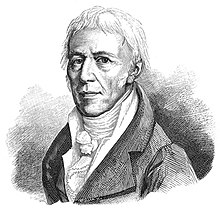Lamark
| Jean-Baptiste Lamarck | |
|---|---|

Portrait by J. Pizzetta, 1893
|
|
| Born |
1 August 1744 Bazentin, Picardy, France |
| Died | 18 December 1829 (aged 85) Paris, France |
| Nationality | French |
| Citizenship | French citizen/subject |
| Known for | Evolution; inheritance of acquired characteristics; Philosophie Zoologique |
| Scientific career | |
| Institutions | French Academy of Sciences; Muséum national d'Histoire naturelle; Jardin des Plantes |
| Influenced | Étienne Geoffroy Saint-Hilaire, William Healey Dall |
| Author abbrev. (botany) | Lam. |
| Author abbrev. (zoology) | Lamarck |
Jean-Baptiste Pierre Antoine de Monet, Chevalier de Lamarck (1 August 1744 – 18 December 1829), often known simply as Lamarck (/ləˈmɑːrk/;French: [lamaʁk]), was a French naturalist. He was a soldier, biologist, academic, and an early proponent of the idea that biological evolution occurred and proceeded in accordance with natural laws.
Lamarck fought in the Pomeranian War (1757–62) against Prussia, and was awarded a commission for bravery on the battlefield. Posted to Monaco, Lamarck became interested in natural history and resolved to study medicine. He retired from the army after being injured in 1766, and returned to his medical studies. Lamarck developed a particular interest in botany, and later, after he published the three-volume work Flore françoise (1778), he gained membership of the French Academy of Sciences in 1779. Lamarck became involved in the Jardin des Plantes and was appointed to the Chair of Botany in 1788. When the French National Assembly founded the Muséum national d'Histoire naturelle in 1793, Lamarck became a professor of zoology.
In 1801, he published Système des animaux sans vertèbres, a major work on the classification of invertebrates, a term he coined. In an 1802 publication he became one of the first to use the term biology in its modern sense. Lamarck continued his work as a premier authority on invertebrate zoology. He is remembered, at least in malacology, as a taxonomist of considerable stature.
...
Wikipedia
